Announcement: Chapter quizzes are not working as of summer 2023.
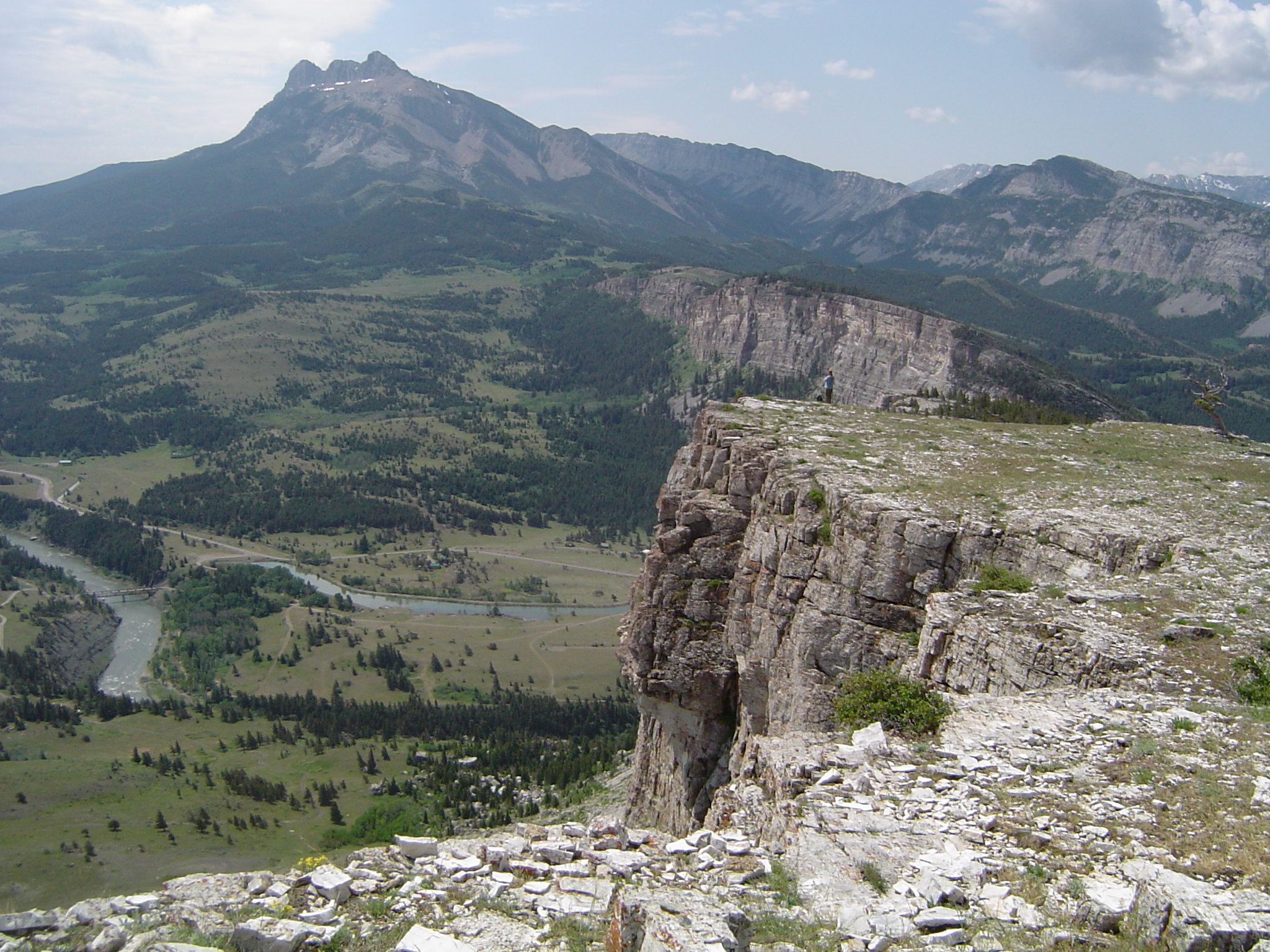
2 Plate Tectonics
KEY CONCEPTS
At the end of this chapter, students should be able to:
- Describe how the ideas behind plate tectonics started with Alfred Wegener’s hypothesis of continental drift
- Describe the physical and chemical layers of the Earth and how they affect plate movement
- Explain how movement at the three types of plate boundaries causes earthquakes, volcanoes, and mountain building
- Identify convergent boundaries, including subduction and collisions, as places where plates come together
- Identify divergent boundaries, including rifts and mid-ocean ridges, as places where plates separate
- Explain transform boundaries as places where adjacent plates shear past each other
- Describe the Wilson Cycle, beginning with continental rifting, ocean basin creation, plate subduction, and ending with ocean basin closure
- Explain how the tracks of hotspots, places that have continually rising magma, is used to calculate plate motion
![By Eric Gaba (Sting - fr:Sting) [<a href="http://creativecommons.org/licenses/by-sa/2.5">CC BY-SA 2.5</a>], <a href="https://commons.wikimedia.org/wiki/File%3ATectonic_plates_boundaries_detailed-en.svg">via Wikimedia Commons</a> The map shows types of plate boundaries around the world and movement direction,](https://opengeology.org/textbook/wp-content/uploads/2016/07/Tectonic_plates_boundaries_detailed-en.svg_-1024x515.png)
The concept of plate tectonics was just as revolutionary for geology. The theory of plate tectonics attributes the movement of massive sections of the Earth’s outer layers with creating earthquakes, mountains, and volcanoes. Many earth processes make more sense when viewed through the lens of plate tectonics. Because it is so important in understanding how the world works, plate tectonics is the first topic of discussion in this textbook.
2.1 Alfred Wegener’s Continental Drift Hypothesis
![[Public domain], <a href="https://commons.wikimedia.org/wiki/File%3AAlfred_Wegener_ca.1924-30.jpg">via Wikimedia Commons</a> He is a male in a suit.](https://opengeology.org/textbook/wp-content/uploads/2016/07/Alfred_Wegener_ca.1924-30.jpg)
2.1.1 Early Evidence for Continental Drift Hypothesis
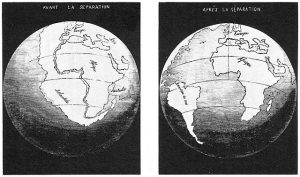
Wegener’s first piece of evidence was that the coastlines of some continents fit together like pieces of a jigsaw puzzle. People noticed the similarities in the coastlines of South America and Africa on the first world maps, and some suggested the continents had been ripped apart. Antonio Snider-Pellegrini did preliminary work on continental separation and matching fossils in 1858.
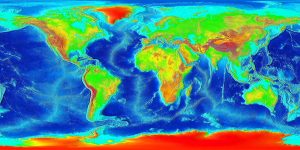
What Wegener did differently was synthesize a large amount of data in one place. He used true edges of the continents, based on the shapes of the continental shelves. This resulted in a better fit than previous efforts that traced the existing coastlines.
![By Osvaldocangaspadilla (Own work) [Public domain], <a href="https://commons.wikimedia.org/wiki/File%3ASnider-Pellegrini_Wegener_fossil_map.svg">via Wikimedia Commons</a> There are four different fossil organisms that connect South America, Africa, India, Antartica, and Australia.](https://opengeology.org/textbook/wp-content/uploads/2017/03/Wegener_fossil_map.svg_-300x231.png)
Opponents of continental drift insisted trans-oceanic land bridges allowed animals and plants to move between continents. The land bridges eventually eroded away, leaving the continents permanently separated. The problem with this hypothesis is the improbability of a land bridge being tall and long enough to stretch across a broad, deep ocean.
More support for continental drift came from the puzzling evidence that glaciers once existed in normally very warm areas in southern Africa, India, Australia, and Arabia. These climate anomalies could not be explained by land bridges. Wegener found similar evidence when he discovered tropical plant fossils in the frozen region of the Arctic Circle. As Wegener collected more data, he realized the explanation that best fit all the climate, rock, and fossil observations involved moving continents.
2.1.2 Proposed Mechanism for Continental Drift
![By User:Oni Lukos (Own work) [<a href="http://www.gnu.org/copyleft/fdl.html">GFDL</a>, <a href="http://creativecommons.org/licenses/by-sa/3.0/">CC-BY-SA-3.0</a> or <a href="http://creativecommons.org/licenses/by-sa/2.5-2.0-1.0">CC BY-SA 2.5-2.0-1.0</a>], <a href="https://commons.wikimedia.org/wiki/File%3AConvection.gif">via Wikimedia Commons</a> The rising material is drawn red. The cool material is blue.](https://opengeology.org/textbook/wp-content/uploads/2016/07/Convection-300x225.gif)
2.1.3 Development of Plate Tectonic Theory
![By NASA [Public domain], <a href="https://commons.wikimedia.org/wiki/File%3AGlobal_plate_motion_2008-04-17.jpg">via Wikimedia Commons</a> The map shows many data points all over the world.](https://opengeology.org/textbook/wp-content/uploads/2016/07/Global_plate_motion_2008-04-17-300x212.jpg)
Mapping of the Ocean Floors
![Originally uploaded by en:user:Brian0918 [Public domain], <a href="https://commons.wikimedia.org/wiki/File%3ADeep_sea_vent_chemistry_diagram.jpg">via Wikimedia Commons</a> The diagram shows water going into the ground and coming out, with many different reactions.](https://opengeology.org/textbook/wp-content/uploads/2017/01/Deep_sea_vent_chemistry_diagram-300x174.jpg)
Seafloor sediment, measured by dredging and drilling, provided another clue. Scientists once believed sediment accumulated on ocean floors over a very long time in a static environment. When some studies showed less sediment than expected, these results were initially used to argue against continental movement. With more time, researchers discovered these thinner sediment layers were located close to mid-ocean ridges, indicating the ridges were younger than the surrounding ocean floor. This finding supported the idea that the sea floor was not fixed in one place.
Paleomagnetism
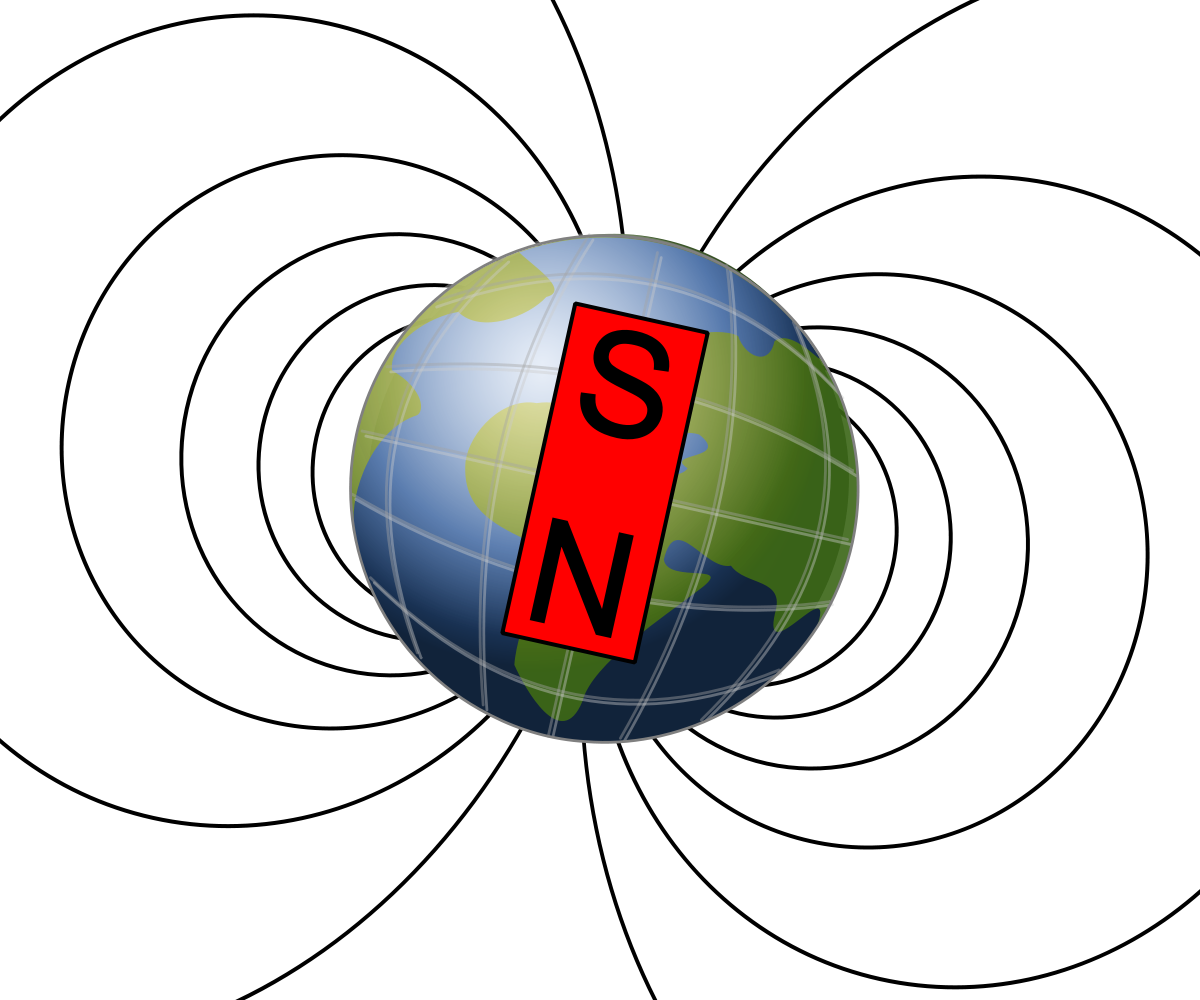
The seafloor was also mapped magnetically. Scientists had long known of strange magnetic anomalies that formed a striped pattern of symmetrical rows on both sides of mid-oceanic ridges. What made these features unusual was the north and south magnetic poles within each stripe were reversed in alternating rows. By 1963, Harry Hess and other scientists used these magnetic reversal patterns to support their model for seafloor spreading (see also Lawrence W. Morley).
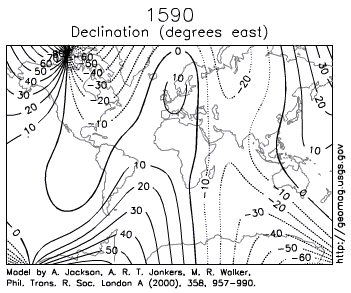
Paleomagnetism is the study of magnetic fields frozen within rocks, basically a fossilized compass. In fact, the first hard evidence to support plate motion came from paleomagnetism.
Igneous rocks containing magnetic minerals like magnetite typically provide the most useful data. In their liquid state as magma or lava, the magnetic poles of the minerals align themselves with the Earth’s magnetic field. When the rock cools and solidifies, this alignment is frozen into place, creating a permanent paleomagnetic record that includes magnetic inclination related to global latitude, and declination related to magnetic north.
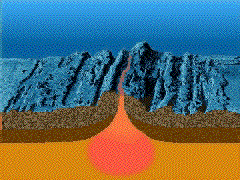
Scientists had noticed for some time the alignment of magnetic north in many rocks was nowhere close to the earth’s current magnetic north. Some explained this away as part of the normal movement of earth’s magnetic north pole. Eventually, scientists realized adding the idea of continental movement explained the data better than pole movement alone.
Wadati-Benioff Zones
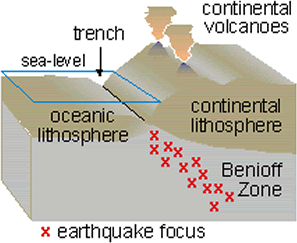
Around the same time mid-ocean ridges were being investigated, other scientists linked the creation of ocean trenches and island arcs to seismic activity and tectonic plate movement. Several independent research groups recognized earthquake epicenters traced the shapes of oceanic plates sinking into the mantle. These deep earthquake zones congregated in planes that started near the surface around ocean trenches and angled beneath the continents and island arcs. Today these earthquake zones are called Wadati-Benioff zones.
![Stephen Morris [<a href="http://creativecommons.org/licenses/by-sa/3.0">CC BY-SA 3.0</a> or <a href="http://www.gnu.org/copyleft/fdl.html">GFDL</a>], <a href="https://commons.wikimedia.org/wiki/File%3AJohn_Tuzo_Wilson_in_1992.jpg">via Wikimedia Commons</a> He is an older man in this 1992 image.](https://opengeology.org/textbook/wp-content/uploads/2016/07/John_Tuzo_Wilson_in_1992-244x300.jpg)
[ays_quiz id=”9″]
2.2 Layers of the Earth
![Derivative work: Anasofiapaixao Earth_internal_structure.png: USGS (Earth_internal_structure.png) [Public domain], <a href="https://commons.wikimedia.org/wiki/File%3AEarth-cutaway-schematic-english.svg">via Wikimedia Commons</a> The crust and lithosphere are on the outside of the Earth and are thin. Below the crust is the mantle and core. Below the lithosphere is the asthenosphere.](https://opengeology.org/textbook/wp-content/uploads/2017/03/Earth-cutaway-schematic-english.svg_-300x211.png)
2.2.1 Chemical Layers
Certainly, the earth is composed of countless combinations of elements. Regardless of what elements are involved two major factors—temperature and pressure—are responsible for creating three distinct chemical layers.
Crust
The outermost chemical layer and the one we currently reside on is the crust. There are two types of crust. The continental crust has a relatively low density and composition similar to granite. The oceanic crust has a relatively high density, especially when cold and old, and its composition is similar to basalt. The surface of the crust is relatively brittle. The deeper parts of the crust are subjected to higher temperatures and pressure, which makes them more ductile. Ductile materials are like soft plastics or putty, they move under force. Brittle materials are like solid glass or pottery, they break under force, especially when it is applied quickly. Earthquakes, generally occur in the upper crust and are caused by the rapid movement of relatively brittle materials.
![By AllenMcC. (Own work) [<a href="http://creativecommons.org/licenses/by-sa/3.0">CC BY-SA 3.0</a>], <a href="https://commons.wikimedia.org/wiki/File%3AMohomap.png">via Wikimedia Commons</a> Places with mountain building have a deeper moho.](https://opengeology.org/textbook/wp-content/uploads/2017/03/MohoDepth-300x167.png)
Mantle
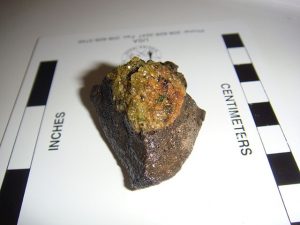
The mantle sits below the crust and above the core. It is the largest chemical layer by volume, extending from the base of the crust to a depth of about 2900 km. Most of what we know about the mantle comes from seismic wave analysis, though information is also gathered by studying ophiolites and xenoliths. Ophiolites are pieces of the mantle that have risen through the crust until they are exposed as part of the ocean floor. Xenoliths are carried within magma and brought to the Earth’s surface by volcanic eruptions. Most xenoliths are made of peridotite, an ultramafic class of igneous rock (see chapter 4.2 for an explanation). Because of this, scientists hypothesize most of the mantle is made of peridotite.
Core
![By H. Raab (User:Vesta) (Own work) [<a href="http://www.gnu.org/copyleft/fdl.html">GFDL</a> or <a href="http://creativecommons.org/licenses/by-sa/3.0/">CC-BY-SA-3.0</a>], <a href="https://commons.wikimedia.org/wiki/File%3ATolucaMeteorite.jpg">via Wikimedia Commons</a> The meteorite is polished showing the Widmanstätten Pattern.](https://opengeology.org/textbook/wp-content/uploads/2016/07/02.2_TolucaMeteorite-300x225.jpg)
2.2.2 Physical Layers
The Earth can also be broken down into five distinct physical layers based on how each layer responds to stress. While there is some overlap in the chemical and physical designations of layers, specifically the core-mantle boundary, there are significant differences between the two systems.
Lithosphere
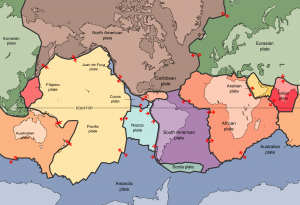
Lithos is Greek for stone, and the lithosphere is the outermost physical layer of the Earth. It is grouped into two types: oceanic and continental. The oceanic lithosphere is thin and relatively rigid. It ranges in thickness from nearly zero in new plates found around mid-ocean ridges, to an average of 140 km in most other locations. The Continental lithosphere is generally thicker and considerably more plastic, especially at the deeper levels. Its thickness ranges from 40 to 280 km. The lithosphere is not continuous. It is broken into segments called plates. A plate boundary is where two plates meet and move relative to each other. Plate boundaries are where we see plate tectonics in action—mountain building, triggering earthquakes, and generating volcanic activity.
Asthenosphere
![<a href="https://en.wikipedia.org/wiki/User:NealeyS" class="extiw" title="wikipedia:User:NealeyS">NealeyS</a> at <a href="https://en.wikipedia.org/wiki/" class="extiw" title="wikipedia:">English Wikipedia</a> [<a href="http://creativecommons.org/licenses/by-sa/3.0">CC BY-SA 3.0</a>], <a href="https://commons.wikimedia.org/wiki/File%3AEarth's_Inner_Layers_denoting_the_LAB.png">via Wikimedia Commons</a> It is thin at a mid-ocean ridge, thick under collisions](https://opengeology.org/textbook/wp-content/uploads/2016/07/Earths_Inner_Layers_denoting_the_LAB-300x207.png)
Mesosphere
![By Cadmium at English Wikipedia (Transferred from en.wikipedia to Commons.) [Public domain], <a href="https://commons.wikimedia.org/wiki/File%3APerovskite.jpg">via Wikimedia Commons</a> The atoms are arranged.](https://opengeology.org/textbook/wp-content/uploads/2016/07/Perovskite-300x288.jpg)
Inner and Outer Core

The outer core is the only entirely liquid layer within the Earth. It starts at a depth of 2,890 km and extends to 5,150 km, making it about 2,300 km thick. In 1936, the Danish geophysicist Inge Lehmann analyzed seismic data and was the first to prove a solid inner core existed within a liquid outer core. The solid inner core is about 1,220 km thick, and the outer core is about 2,300 km thick.
It seems like a contradiction that the hottest part of the Earth is solid, as the minerals making up the core should be liquified or vaporized at this temperature. Immense pressure keeps the minerals of the inner core in a solid phase. The inner core grows slowly from the lower outer core solidifying as heat escapes the interior of the Earth and is dispersed to the outer layers.

The earth’s liquid outer core is critically important in maintaining a breathable atmosphere and other environmental conditions favorable for life. Scientists believe the earth’s magnetic field is generated by the circulation of molten iron and nickel within the outer core. If the outer core were to stop circulating or become solid, the loss of the magnetic field would result in Earth getting stripped of life-supporting gases and water. This is what happened, and continues to happen, on Mars.
2.2.3 Plate Tectonic Boundaries
![By Joshua Doubek (Own work) [<a href="http://creativecommons.org/licenses/by-sa/3.0">CC BY-SA 3.0</a>], <a href="https://commons.wikimedia.org/wiki/File%3APassive_Contiental_Margin.jpg">via Wikimedia Commons</a> The plate thins from continent to ocean](https://opengeology.org/textbook/wp-content/uploads/2016/07/Passive_Contiental_Margin-300x143.jpg)
![By Jose F. Vigil. USGS ([1]) [Public domain], <a href="https://commons.wikimedia.org/wiki/File%3ATectonic_plate_boundaries.png">via Wikimedia Commons</a> It shows all the types](https://opengeology.org/textbook/wp-content/uploads/2016/07/Tectonic_plate_boundaries.png)
[ays_quiz id=”10″]
2.3 Convergent Boundaries
![By USGS (http://earthquake.usgs.gov/data/crust/maps.php) [Public domain], <a href="https://commons.wikimedia.org/wiki/File%3AWorld_geologic_provinces.jpg">via Wikimedia Commons</a> The legend shows shields, platforms, orogens, basins, large igneous provinces, and extended crust.](https://opengeology.org/textbook/wp-content/uploads/2017/03/CratonGeolProv-300x159.jpg)
When plates of different densities converge, the higher-density plate is pushed beneath the more buoyant plate in a process called subduction. When continental plates converge without subduction occurring, this process is called a collision.
2.3.1. Subduction
Video showing continental-oceanic subduction, causing volcanism. By Tanya Atwater and John Iwerks.
Subduction occurs when a dense oceanic plate meets a more buoyant plate, like a continental plate or warmer/younger oceanic plate, and descends into the mantle. The worldwide average rate of oceanic plate subduction is 25 miles per million years, about a half-inch per year. As an oceanic plate descends, it pulls the ocean floor down into a trench. These trenches can be more than twice as deep as the average depth of the adjacent ocean basin, which is usually three to four km. The Mariana Trench, for example, approaches a staggering 11 km.
![By KDS4444 (Own work) [<a href="http://creativecommons.org/licenses/by-sa/4.0">CC BY-SA 4.0</a>], <a href="https://commons.wikimedia.org/wiki/File%3ASubduction-en.svg">via Wikimedia Commons</a> Many features are labeled on the diagram, but the main idea is the ocean plate descending below the continental](https://opengeology.org/textbook/wp-content/uploads/2017/03/Subduction-en.svg_.png)

Within the trench, ocean-floor sediments are scraped together and compressed between the subducting and overriding plates. This feature is called the accretionary wedge, mélange, or accretionary prism. Fragments of continental material, including microcontinents, riding atop the subducting plate may become sutured to the accretionary wedge and accumulate into a large area of land called a terrane. Vast portions of California are comprised of accreted terranes.
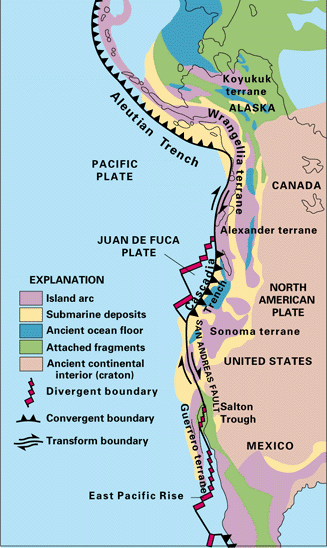
When the subducting oceanic plate, or slab, sinks into the mantle, the immense heat and pressure push volatile materials like water and carbon dioxide into an area below the continental plate and above the descending plate called the mantle wedge. The volatiles are released mostly by hydrated minerals that revert to non-hydrated minerals in these higher temperature and pressure conditions. When mixed with asthenospheric material above the plate, the volatile lower the melting point of the mantle wedge, and through a process called flux melting it becomes liquid magma. The molten magma is more buoyant than the lithospheric plate above it and migrates to the Earth’s surface where it emerges as volcanism. The resulting volcanoes frequently appear as curved mountain chains, volcanic arcs, due to the curvature of the earth. Both oceanic and continental plates can contain volcanic arcs.
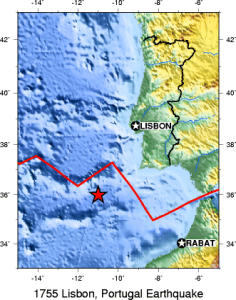
How subduction is initiated is still a matter of scientific debate. It is generally accepted that subduction zones start as passive margins, where oceanic and continental plates come together, and then gravity initiates subduction and converts the passive margin into an active one. One hypothesis is gravity pulls the denser oceanic plate down or the plate can start to flow ductility at a low angle. Scientists seeking to answer this question have collected evidence that suggests a new subduction zone is forming off the coast of Portugal. Some scientists have proposed large earthquakes like the 1755 Lisbon earthquake may even have something to do with this process of creating a subduction zone, although the evidence is not definitive. Another hypothesis proposes subduction happens at transform boundaries involving plates of different densities.
Some plate boundaries look like they should be active, but show no evidence of subduction. The oceanic lithospheric plates on either side of the Atlantic Ocean for example, are denser than the underlying asthenosphere and are not subducting beneath the continental plates. One hypothesis is the bond holding the oceanic and continental plates together is stronger than the downward force created by the difference in plate densities.
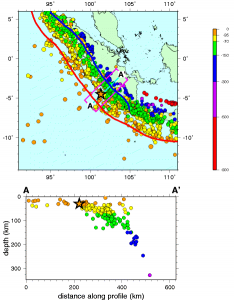
Subduction zones are known for having the largest earthquakes and tsunamis; they are the only places with fault surfaces large enough to create magnitude-9 earthquakes. These subduction-zone earthquakes not only are very large but also very deep. When a subducting slab becomes stuck and cannot descend, a massive amount of energy builds up between the stuck plates. If this energy is not gradually dispersed, it may force the plates to suddenly release along several hundred kilometers of the subduction zone. Because subduction-zone faults are located on the ocean floor, this massive amount of movement can generate giant tsunamis such as those that followed the 2004 Indian Ocean Earthquake and 2011 Tōhoku Earthquake in Japan.
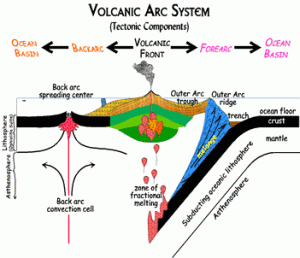
All subduction zones have a forearc basin, a feature of the overriding plate found between the volcanic arc and oceanic trench. The forearc basin experiences a lot of faulting and deformation activity, particularly within the accretionary wedge.
In some subduction zones, tensional forces working on the continental plate create a backarc basin on the interior side of the volcanic arc. Some scientists have proposed a subduction mechanism called oceanic slab rollback that creates extension faults in the overriding plates. In this model, the descending oceanic slab does not slide directly under the overriding plate but instead rolls back, pulling the overlying plate seaward. The continental plate behind the volcanic arc gets stretched like pizza dough until the surface cracks and collapses to form a backarc basin. If the extension activity is extensive and deep enough, a backarc basin can develop into a continental rifting zone. These continental divergent boundaries may be less symmetrical than their mid-ocean ridge counterparts.
In places where numerous young buoyant oceanic plates are converging and subducting at a relatively high velocity, they may force the overlying continental plate to buckle and crack. This is called back-arc faulting. Extensional back-arc faults pull rocks and chunks of plates apart. Compressional back-arc faults, also known as thrust faults, push them together.
The dual spines of the Andes Mountain range include an example of compressional thrust faulting. The western spine is part of a volcanic arc. Thrust faults have deformed the non-volcanic eastern spine, pushing rocks and pieces of the continental plate on top of each other.
There are two styles of thrust fault deformation: thin-skinned faults that occur in superficial rocks lying on top of the continental plate and thick-skinned faults that reach deeper into the crust. The Sevier Orogeny in the western U.S. is a notable thin-skinned type of deformation created during the Cretaceous Period. The Laramide Orogeny, a thick-skinned type of deformation, occurred near the end of and slightly after the Sevier Orogeny in the same region.
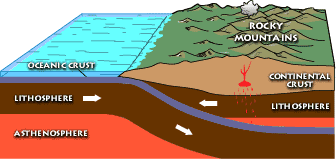
Flat-slab, or shallow, subduction caused the Laramide Orogeny. When the descending slab subducts at a low angle, there is more contact between the slab and the overlying continental plate than in a typical subduction zone. The shallowly-subducting slab pushes against the overriding plate and creates an area of deformation on the overriding plate many kilometers away from the subduction zone.
Oceanic-Continental subduction
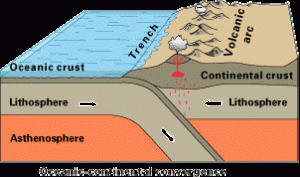
Oceanic-continental subduction occurs when an oceanic plate dives below a continental plate. This convergent boundary has a trench and mantle wedge and frequently, a volcanic arc. Well-known examples of continental volcanic arcs are the Cascade Mountains in the Pacific Northwest and the western Andes Mountains in South America.
Oceanic-Oceanic Subduction
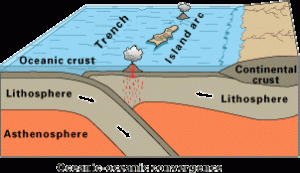
The boundaries of oceanic-oceanic subduction zones show very different activity from those involving oceanic-continental plates. Since both plates are made of oceanic lithosphere, it is usually the older plate that subducts because it is colder and denser. The volcanism on the overlying oceanic plate may remain hidden underwater.. If the volcanoes rise high enough the reach the ocean surface, the chain of volcanism forms an island arc. Examples of these island arcs include the Aleutian Islands in the northern Pacific Ocean, the Lesser Antilles in the Caribbean Sea, and numerous island chains scattered throughout the western Pacific Ocean.
2.3.2. Collisions
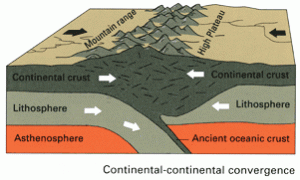
When continental plates converge, during the closing of an ocean basin, for example, subduction is not possible between the equally buoyant plates. Instead of one plate descending beneath another, the two masses of continental lithosphere slam together in a process known as a collision. Without subduction, there is no magma formation and no volcanism. Collision zones are characterized by tall, non-volcanic mountains; a broad zone of frequent, large earthquakes; and very little volcanism.
When oceanic crust connected by a passive margin to continental crust completely subducts beneath a continent, an ocean basin closes, and continental collision begins. Eventually, as ocean basins close, continents join together to form a massive accumulation of continents called a supercontinent, a process that has taken place in ~500 million-year-old cycles over the earth’s history.
![By en:User:Kieff (File:Pangaea continents.png) [<a href="http://www.gnu.org/copyleft/fdl.html">GFDL</a> or <a href="http://creativecommons.org/licenses/by-sa/3.0/">CC-BY-SA-3.0</a>], <a href="https://commons.wikimedia.org/wiki/File%3APangaea_continents.svg">via Wikimedia Commons</a> Pangaea has a crescent shape.](https://opengeology.org/textbook/wp-content/uploads/2017/02/Pangaea_continents-267x300.png)
![By Mikenorton (Own work) [<a href="http://creativecommons.org/licenses/by-sa/3.0">CC BY-SA 3.0</a> or <a href="http://www.gnu.org/copyleft/fdl.html">GFDL</a>], <a href="https://commons.wikimedia.org/wiki/File%3AZagrosFTB.png">via Wikimedia Commons</a> The mountains are loading the crust down, leading to a depressed basin, which is the Persian Gulf](https://opengeology.org/textbook/wp-content/uploads/2016/07/ZagrosFTB-300x231.png)
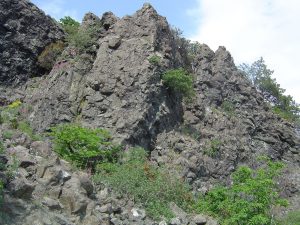
If continental and oceanic lithosphere are fused on the same plate, it can partially subduct but its buoyancy prevents it from fully descending. In very rare cases, part of a continental plate may become trapped beneath a descending oceanic plate in a process called obduction. When a portion of the continental crust is driven down into the subduction zone, due to its buoyancy it returns to the surface relatively quickly.
As pieces of the continental lithosphere break loose and migrate upward through the obduction zone, they bring along bits of the mantle and ocean floor and amend them on top of the continental plate. Rocks composed of this mantle and ocean-floor material are called ophiolites and they provide valuable information about the composition of the mantle.
The area of collision-zone deformation and seismic activity usually covers a broader area because the continental lithosphere is plastic and malleable. Unlike subduction-zone earthquakes, which tend to be located along a narrow swath near the convergent boundary, collision-zone earthquakes may occur hundreds of kilometers from the boundary between the plates.
The Eurasian continent has many examples of collision-zone deformations covering vast areas. The Pyrenees mountains begin in the Iberian Peninsula and cross into France. Also, there are the Alps stretching from Italy to central Europe; the Zagros mountains from Arabia to Iran; and the Himalayan mountains from the Indian subcontinent to central Asia.
Animation of India crashing into Asia, by Tanya Atwater.
[ays_quiz id=”11″]
2.4 Divergent Boundaries
At divergent boundaries, sometimes called constructive boundaries, lithospheric plates move away from each other. There are two types of divergent boundaries, categorized by where they occur: continental rift zones and mid-ocean ridges. Continental rift zones occur in weak spots in the continental lithospheric plate. A mid-ocean ridge usually originates in a continental plate as a rift zone that expands to the point of splitting the plate apart, with seawater filling in the gap. The separate pieces continue to drift apart and become individual continents. This process is known as rift-to-drift.
2.4.1. Continental Rifting
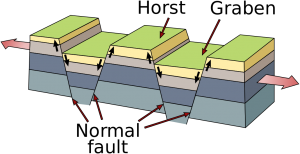
In places where the continental plates are very thick, they reflect so much heat back into the mantle it develops strong convection currents that push super-heated mantle material up against the overlying plate, softening it. Tensional forces created by this convective upwelling begin to pull the weakened plate apart. As it stretches, it becomes thinner and develops deep cracks called extension or normal faults. Eventually, plate sections located between large faults drop into deep depressions known as rift valleys, which often contain keystone-shaped blocks of down-dropped crust known as grabens. The shoulders of these grabens are called horsts. If only one side of a section drops, it is called a half-graben. Depending on the conditions, rifts can grow into very large lakes and even oceans.
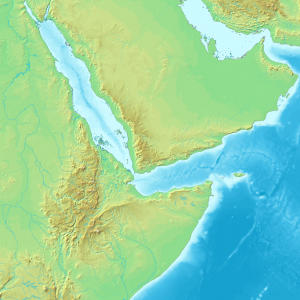
While seemingly occurring at random, rifting is dictated by two factors. Rifting does not occur in continents with older and more stable interiors, known as cratons. When continental rifting does occur, the break-up pattern resembles the seams of a soccer ball, also called a truncated icosahedron. This is the most common surface-fracture pattern to develop on an evenly expanding sphere because it uses the least amount of energy.
Using the soccer ball model, rifting tends to lengthen and expand along a particular seam while fizzling out in the other directions. These seams with little or no tectonic activity are called failed rift arms. A failed rift arm is still a weak spot in the continental plate; even without the presence of active extension faults, it may develop into a called an aulacogen. One example of a failed rift arm is the Mississippi Valley Embayment, a depression through which the upper end of the Mississippi River flows. Occasionally connected rift arms do develop concurrently, creating multiple boundaries of active rifting. In places where the rift arms do not fail, for example, the Afar Triangle, three divergent boundaries can develop near each other forming a triple junction.
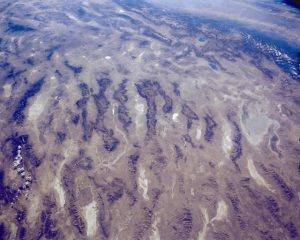
Rifts come in two types: narrow and broad. Narrow rifts are characterized by a high density of highly active divergent boundaries. The East African Rift Zone, where the horn of Africa is pulling away from the mainland, is an excellent example of an active narrow rift. Lake Baikal in Russia is another. Broad rifts also have numerous fault zones, but they are distributed over wide areas of deformation. The Basin and Range region located in the western United States is a type of broad rift. The Wasatch Fault, which also created the Wasatch Mountain Range in the state of Utah, forms the eastern divergent boundary of this broad rift (Animation 1 and Animation 2).
![By USGS (http://pubs.usgs.gov/gip/dynamic/East_Africa.html) [Public domain], <a href="https://commons.wikimedia.org/wiki/File%3AEAfrica.png">via Wikimedia Commons</a> The rift is a series of valleys in eastern Africa.](https://opengeology.org/textbook/wp-content/uploads/2016/07/EAfricaRift-300x252.png)
South America and Africa rift, forming the Atlantic. Video by Tanya Atwater.
2.4.2. Mid-ocean ridges
![By Ocean-birth_hg.png: Hannes Grobe, Alfred Wegener Institute for Polar and Marine Research, vectorised by User:Lichtspielderivative work: Lichtspiel (Ocean-birth_hg.png) [<a href="http://creativecommons.org/licenses/by-sa/2.5">CC BY-SA 2.5</a>], <a href="https://commons.wikimedia.org/wiki/File%3AOcean-birth.svg">via Wikimedia Commons</a> The ocean starts as a valley and then gets wider and wider.](https://opengeology.org/textbook/wp-content/uploads/2017/03/Ocean-birth.svg_-212x300.png)
Mid-ocean ridges, also known as spreading centers, have several distinctive features. They are the only places on earth that create new oceanic lithosphere. Decompression melting in the rift zone changes asthenosphere material into the new lithosphere, which oozes up through cracks in the oceanic plate. The amount of new lithosphere being created at mid-ocean ridges is highly significant. These undersea rift volcanoes produce more lava than all other types of volcanism combined. Despite this, most mid-oceanic ridge volcanism remains unmapped because the volcanoes are located deep on the ocean floor.
In rare cases, such as a few locations in Iceland, rift zones display the type of volcanism, spreading, and ridge formation found on the ocean floor.
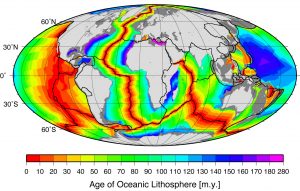
The ridge feature is created by the accumulation of hot lithosphere material, which is lighter than the dense underlying asthenosphere. This chunk of isostatically buoyant lithosphere sits partially submerged and partially exposed on the asthenosphere, like an ice cube floating in a glass of water.
As the ridge continues to spread, the lithosphere material is pulled away from the area of volcanism and becomes colder and denser. As it continues to spread and cool, the lithosphere settles into wide swathes of relatively featureless topography called abyssal plains with lower topography.
This model of ridge formation suggests the sections of lithosphere furthest away from the mid-ocean ridges will be the oldest. Scientists have tested this idea by comparing the age of rocks located in various locations on the ocean floor. Rocks found near ridges are younger than those found far away from any ridges. Sediment accumulation patterns also confirm the idea of sea-floor spreading. Sediment layers tend to be thinner near mid-ocean ridges, indicating it has had less time to build up.
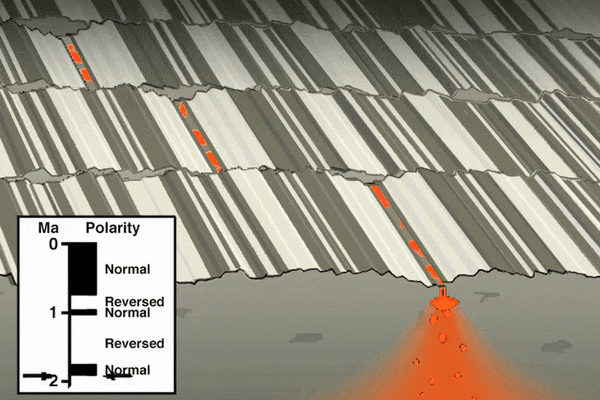
![By Chmee2 [Public domain], <a href="https://commons.wikimedia.org/wiki/File%3AOceanic.Stripe.Magnetic.Anomalies.Scheme.svg">via Wikimedia Commons</a> The older stripes are farther from the ridge.](https://opengeology.org/textbook/wp-content/uploads/2017/03/Oceanic.Stripe.Magnetic.Anomalies.Scheme.svg_-300x212.png)
Video of the breakup of Pangea and the formation of the northern Atlantic Ocean. By Tanya Atwater.
![By University of Washington; NOAA/OAR/OER. (NOAA Photo Library: expl2366) [<a href="http://creativecommons.org/licenses/by/2.0">CC BY 2.0</a> or Public domain], <a href="https://commons.wikimedia.org/wiki/File%3AExpl2366_-_Flickr_-_NOAA_Photo_Library.jpg">via Wikimedia Commons</a> There is a large build up of minerals around the vent](https://opengeology.org/textbook/wp-content/uploads/2016/07/BlackSmoker-233x300.jpg)
Scientists had known about these geothermal areas on the ocean floor for some time. However, it was not until 1977, when scientists piloting a deep submergence vehicle, the Alvin, discovered a thriving community of organisms clustered around these hydrothermal vents. These unique organisms, which include 10-foot-long tube worms taller than people, live in the complete darkness of the ocean floor deprived of oxygen and sunlight. They use geothermal energy provided by the vents and a process called bacterial chemosynthesis to feed on sulfur compounds. Before this discovery, scientists believed life on earth could not exist without photosynthesis, a process that requires sunlight. Some scientists suggest this type of environment could have been the origin of life on Earth, and perhaps even extraterrestrial life elsewhere in the galaxy, such as on Jupiter’s moon Europa.
[ays_quiz id=”12″]
2.5 Transform Boundaries
![By Cferrero at English Wikipedia (Transferred from en.wikipedia to Commons.) [<a href="http://www.gnu.org/copyleft/fdl.html">GFDL</a> or <a href="http://creativecommons.org/licenses/by-sa/3.0/">CC-BY-SA-3.0</a>], <a href="https://commons.wikimedia.org/wiki/File%3AStrike_slip_fault.png">via Wikimedia Commons</a> Sinistral moves to the left, dextral moves to the right.](https://opengeology.org/textbook/wp-content/uploads/2017/03/Strike_slip_fault-300x137.png)
Most transform boundaries are found on the ocean floor, around mid-ocean ridges. These boundaries form aseismic fracture zones, filled with earthquake-free transform faults, to accommodate different rates of spreading occurring at the ridge.
![By Kate Barton, David Howell, and Joe Vigil [Public domain], <a href="https://commons.wikimedia.org/wiki/File%3ASanandreas.jpg">via Wikimedia Commons</a> The fault runs through California.](https://opengeology.org/textbook/wp-content/uploads/2016/07/Sanandreas-217x300.jpg)
In the eyes of humanity, the most significant transform faults occur within continental plates and have a shearing motion that frequently produces moderate-to-large magnitude earthquakes. Notable examples include the San Andreas Fault in California, the Northern and Eastern Anatolian Faults in Turkey, the Altyn Tagh Fault in central Asia, and the Alpine Fault in New Zealand.
2.5.1. Transpression and Transtension
![By GeoAsh (Own work) [<a href="http://creativecommons.org/licenses/by-sa/4.0">CC BY-SA 4.0</a>], <a href="https://commons.wikimedia.org/wiki/File%3ARestraining_Bend.png">via Wikimedia Commons</a> The fault is dextral, and has a leftward bend, causing uplift.](https://opengeology.org/textbook/wp-content/uploads/2017/03/Transpression-150x150.png)
![By K. Martin (Own work) [<a href="http://creativecommons.org/licenses/by-sa/3.0">CC BY-SA 3.0</a>], <a href="https://commons.wikimedia.org/wiki/File%3AReleasing_bend.png">via Wikimedia Commons</a> The fault is dextral, and has a rightward bend, causing a valley.](https://opengeology.org/textbook/wp-content/uploads/2017/03/Transtension.png)
2.5.2. Piercing Points
![By Robert E. Wallace [Public domain], <a href="https://commons.wikimedia.org/wiki/File%3AWallace_Creek_offset_across_the_San_Andreas_Fault.png">via Wikimedia Commons</a> The offset is to the left.](https://opengeology.org/textbook/wp-content/uploads/2017/03/Wallace_Creek_offset_across_the_San_Andreas_Fault-300x205.png)
Video of the origin of the San Andreas fault. As the mid-ocean ridge subducts, the relative motion between the remaining plates becomes a transform boundary, forming the fault system. Note that because the motion of the plates is not exactly parallel to the fault, it causes divergent motion in the interior of North America. By Tanya Atwater.
[ays_quiz id=”13″]
2.6 The Wilson Cycle
![By Hannes Grobe 08:34, 21 January 2007 (UTC)Derivative work: Hardwigg (File:Wilson-cycle hg.png) [<a href="http://creativecommons.org/licenses/by-sa/2.5">CC BY-SA 2.5</a>], <a href="https://commons.wikimedia.org/wiki/File%3AWilson-cycle_hg.svg">via Wikimedia Commons</a> The diagram shows the last 1000 million years.](https://opengeology.org/textbook/wp-content/uploads/2017/03/Wilson-cycle_hg.svg_-300x164.png)
There are a number of hypotheses about how the Wilson Cycle works. One mechanism proposes that rifting happens because continental plates reflect the heat much better than oceanic plates. When continents congregate together, they reflect more of the Earth’s heat back into the mantle, generating more vigorous convection currents that then start the continental rifting process. Some geologists believe mantle plumes are remnants of these periods of increased mantle temperature and convection upwelling, and study them for clues about the origin of continental rifting.
The mechanism behind how supercontinents are created is still largely a mystery. There are three schools of thought about what continues to drive the continents further apart and eventually bring them together. The ridge-push hypothesis suggests after the initial rifting event, plates continue to be pushed apart by mid-ocean spreading centers and their underlying convection currents. Slab-pull proposes the plates are pulled apart by descending slabs in the subduction zones of the oceanic-continental margins. A third idea, gravitational sliding, attributes the movement to gravitational forces pulling the lithospheric plates down from the elevated mid-ocean ridges and across the underlying asthenosphere. Current evidence seems to support slab pull more than ridge push or gravitational sliding.
2.7 Hotspots
![By Los688 (my own work) [Public domain], <a href="https://commons.wikimedia.org/wiki/File%3AHotspot(geology)-1.svg">via Wikimedia Commons</a> The plate is moving to the left, the magma stays in the center am makes a chain of volcanoes.](https://opengeology.org/textbook/wp-content/uploads/2017/03/Hotspotgeology-1.svg_-193x300.png)
![By Foulger (Own work) [Public domain], <a href="https://commons.wikimedia.org/wiki/File%3ACourtHotspots.png">via Wikimedia Commons</a> Hotspots are scattered around the world.](https://opengeology.org/textbook/wp-content/uploads/2017/03/HotspotsWorld-300x175.png)
Scientists are divided over how magma is generated in hotspots. Some suggest that hotspots originate from super-heated material from as deep as the core that reaches the Earth’s crust as a mantle plume. Others argue the molten material that feeds hotspots is sourced from the mantle. Of course, it is difficult to collect data from these deep-Earth features due to the extremely high pressure and temperature.
How hotspots are initiated is another highly debated subject. The prevailing mechanism has hotspots starting in divergent boundaries during supercontinent rifting. Scientists have identified a number of current and past hotspots believed to have begun this way. Subducting slabs have also been named as causing mantle plumes and hot-spot volcanism. Some geologists have suggested another geological process not involving plate tectonics may be involved, such as a large space object crashing into Earth. Regardless of how they are formed, dozens are on the Earth. Some well-known examples include the Tahiti Islands, Afar Triangle, Easter Island, Iceland, Galapagos Islands, and Samoan Islands. The United States is home to two of the largest and best-studied hotspots: Hawaii and Yellowstone.
2.7.1 Hawaiian hotspot
![By Ingo Wölbern (own work, created with GMT Software) [Public domain], <a href="https://commons.wikimedia.org/wiki/File%3AHawaii-Emperor_engl.png">via Wikimedia Commons</a> There are a series of island and seamounts in the Pacific Ocean, with a bend in the middle.](https://opengeology.org/textbook/wp-content/uploads/2016/07/Hawaii-Emperor_engl-296x300.png)
This enormous volcanic island chain, much of which is underwater, stretches across the Pacific for almost 6,000 km. The seamount chain’s most striking feature is a sharp 60-degree bend located at the midpoint, which marks a significant change in plate movement direction that occurred 50 million years ago. The change in direction has been more often linked to a plate reconfiguration, but also to other things like plume migration.
![By Joel E. Robinson, USGS. [Public domain], <a href="https://commons.wikimedia.org/wiki/File%3AHawaii_hotspot_cross-sectional_diagram.jpg">via Wikimedia Commons</a> The islands get older to the left.](https://opengeology.org/textbook/wp-content/uploads/2017/03/Hawaii_hotspot_cross-sectional_diagram-300x159.jpg)
2.7.2 Yellowstone hotspot
![<a href="https://en.wikipedia.org/wiki/User:Kelvin_Case" class="extiw" title="wikipedia:User:Kelvin Case">Kelvin Case</a> at <a href="https://en.wikipedia.org/wiki/" class="extiw" title="wikipedia:">English Wikipedia</a> [<a href="http://creativecommons.org/licenses/by/3.0">CC BY 3.0</a>], <a href="https://commons.wikimedia.org/wiki/File%3AHotspotsSRP_update2013.JPG">via Wikimedia Commons</a> The hotspot started near the Idaho-Oregon-Nevada boarder, then moved toward its present location neat the Wyoming-Idaho-Montana boarder.](https://opengeology.org/textbook/wp-content/uploads/2017/03/YellowstoneHotspot-300x206.jpg)
Over 15 million years of eruptions by this hotspot have carved a curved path across the western United States. It has been suggested the Yellowstone hotspot is connected to the much older Columbia River flood basalts and even to the 70 million-year-old volcanism found in the Yukon region of Canada.
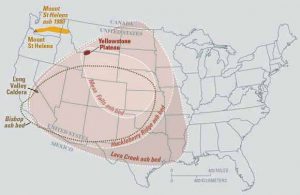
The most recent major eruption of this hotspot created the Yellowstone Caldera and Lava Creek tuff formation approximately 631,000 years ago. The eruption threw 1,000 cubic kilometers of ash and magma into the atmosphere, some of which was found as far away as Mississippi. Should the hotspot erupt again, scientists predict it will be another massive event. This would be a calamity reaching far beyond the western United States. These super volcanic eruptions fill the earth’s atmosphere with so much gas and ash, they block sunlight from reaching the earth. Not only would this drastically alter climates and environments around the globe, but it could also affect worldwide food production.
[ays_quiz id=”14″]
Summary
Plate tectonics is a unifying theory; it explains nearly all of the major geologic processes on Earth. Since its early inception in the 1950s and 1960s, geologists have been guided by this revolutionary perception of the world. The theory of plate tectonics states the surface layer of the Earth is broken into a network of solid, relatively brittle plates. Underneath the plates is a much hotter and more ductile layer that contains zones of convective upwelling generated by the interior heat of Earth. These convection currents move the surface plates around—bringing them together, pulling them apart, and shearing them side-by-side. Earthquakes and volcanoes form at the boundaries where the plates interact, with the exception of volcanic hotspots, which are not caused by plate movement.
[ays_quiz id=”15″]
References
- Aitta, A., 2006, Iron melting curve with a tricritical point: J. Stat. Mech., v. 2006, no. 12, p. P12015.
- Alfe, D., Gillan, M.J., and Price, G.D., 2002, Composition and temperature of the Earth’s core constrained by combining ab initio calculations and seismic data: Earth Planet. Sci. Lett., v. 195, no. 1, p. 91–98.
- Atwater, T., 1970, Implications of Plate Tectonics for the Cenozoic Tectonic Evolution of Western North America: Geol. Soc. Am. Bull., v. 81, no. 12, p. 3513–3536., doi: 10.1130/0016-7606(1970)81[3513:IOPTFT]2.0.CO;2.
- Bacon, F., and Montagu, B., 1848, The Works of Francis Bacon, Lord Chancellor of England: With a Life of the Author: The Works of Francis Bacon, Lord Chancellor of England: With a Life of the Author, Parry & McMillan, The Works of Francis Bacon, Lord Chancellor of England: With a Life of the Author.
- Benioff, H., 1949, Seismic evidence for the fault origin of oceanic deeps: Geological Society of America Bulletin, v. 60, no. 12, p. 1837–1856., doi: 10.1130/0016-7606(1949)60[1837:SEFTFO]2.0.CO;2.
- Birch, F., 1952, Elasticity and constitution of the Earth’s interior: J. Geophys. Res., v. 57, no. 2, p. 227–286., doi: 10.1029/JZ057i002p00227.
- Birch, F., 1964, Density and composition of mantle and core: J. Geophys. Res., v. 69, no. 20, p. 4377–4388.
- Bott, M.H.P., 1993, Modelling the plate-driving mechanism: Journal of the Geological Society, v. 150, no. 5, p. 941–951., doi: 10.1144/gsjgs.150.5.0941.
- Coats, R.R., 1962, Magma type and crustal structure in the Aleutian Arc, in The Crust of the Pacific Basin: American Geophysical Union, p. 92–109., doi: 10.1029/GM006p0092.
- Conrad, C.P., and Lithgow-Bertelloni, C., 2002, How mantle slabs drive plate tectonics: Science (New York, N.Y.), v. 298, no. 5591, p. 207–209., doi: 10.1126/science.1074161.
- Corliss, J.B., Dymond, J.G., Gordon, L.I., Edmond, J.M., von Heezen, R.P., Ballard, R.D., Green, K., Williams, D.L., Bainbridge, A., Crane, K., and van Andel, T.H., 1979, Submarine thermal springs on the Galapagos Rift: Science, v. 203, p. 107321083.
- Davis, E.E., and Lister, C.R.B., 1974, Fundamentals of ridge crest topography: Earth Planet. Sci. Lett., v. 21, no. 4, p. 405–413.
- Dawson, J.B., Pinkerton, H., Norton, G.E., and Pyle, D.M., 1990, Physicochemical properties of alkali carbonatite lavas:Data from the 1988 eruption of Oldoinyo Lengai, Tanzania: Geology, v. 18, no. 3, p. 260–263.
- Drake, E.T., 1976, Alfred Wegener’s reconstruction of Pangea: Geology, v. 4, no. 1, p. 41–44., doi: 10.1130/0091-7613(1976)4<41:AWROP>2.0.CO;2.
- Engdahl, E.R., Flynn, E.A., and Masse, R.P., 1974, Differential PkiKP travel times and the radius of the core: Geophysical J Royal Astro Soc, v. 40, p. 457–463.
- Ewing, M., Ewing, J.I., and Talwani, M., 1964, Sediment distribution in the oceans: The Mid-Atlantic Ridge: Geol. Soc. Am. Bull., v. 75, no. 1, p. 17–36., doi: 10.1130/0016-7606(1964)75[17:SDITOT]2.0.CO;2.
- Ewing, M., Houtz, R., and Ewing, J., 1969, South Pacific sediment distribution: J. Geophys. Res., v. 74, no. 10, p. 2477–2493., doi: 10.1029/JB074i010p02477.
- Fernandez, L.M., and Careaga, J., 1968, The thickness of the crust in central United States and La Paz, Bolivia, from the spectrum of longitudinal seismic waves: Bull. Seismol. Soc. Am., v. 58, no. 2, p. 711–741.
- Fluegel, von H.W., 1980, Wegener-Ampferer-Schwinner. Ein Beitrag zur Geschichte der Geologie in Österreich: Mitt. Oesterr. Geol. Ges., v. 73, p. 237–254.
- Forsyth, D.W., 1975, The Early Structural Evolution and Anisotropy of the Oceanic Upper Mantle: Geophys. J. Int., v. 43, no. 1, p. 103–162., doi: 10.1111/j.1365-246X.1975.tb00630.x.
- Frankel, H., 1982, The Development, Reception, and Acceptance of the Vine-Matthews-Morley Hypothesis: Hist. Stud. Phys. Biol. Sci., v. 13, no. 1, p. 1–39.
- Fukao, Y., and Obayashi, M., 2013, Subducted slabs stagnant above, penetrating through, and trapped below the 660 km discontinuity: J. Geophys. Res. [Solid Earth], v. 118, no. 11, p. 2013JB010466.
- Hagstrum, J.T., 2005, Antipodal hotspots and bipolar catastrophes: Were oceanic large-body impacts the cause? Earth Planet. Sci. Lett., v. 236, no. 1–2, p. 13–27.
- Hanks, T.C., and Anderson, D.L., 1969, The early thermal history of the earth: Phys. Earth Planet. Inter., v. 2, no. 1, p. 19–29.
- Heezen, B.C., and Tharp, M., 1965, Tectonic Fabric of the Atlantic and Indian Oceans and Continental Drift: Philosophical Transactions of the Royal Society of London A: Mathematical, Physical and Engineering Sciences, v. 258, no. 1088, p. 90–106., doi: 10.1098/rsta.1965.0024.
- Heller, P.L., Bowdler, S.S., Chambers, H.P., Coogan, J.C., Hagen, E.S., Shuster, M.W., Winslow, N.S., and Lawton, T.F., 1986, Time of initial thrusting in the Sevier orogenic belt, Idaho-Wyoming and Utah: Geology, v. 14, no. 5, p. 388–391.
- Herak, D., and Herak, M., 2007, Andrija Mohorovičić (1857-1936)—On the occasion of the 150th anniversary of his birth: Seismol. Res. Lett., v. 78, no. 6, p. 671–674.
- Hess, H.H., 1962, History of ocean basins: Petrologic studies, v. 4, p. 599–620.
- Hutson, P., Middleton, J., and Miller, D., 2003, Collision Zones: Online, http://www.geosci.usyd.edu.au/users/prey/ACSGT/EReports/eR.2003/GroupD/Report1/web%20pages/contents.html, accessed June 2017.
- Isacks, B., Oliver, J., and Sykes, L.R., 1968, Seismology and the new global tectonics: J. Geophys. Res., v. 73, no. 18, p. 5855–5899.
- Ito, E., and Takahashi, E., 1989, Postspinel transformations in the system Mg2SiO4-Fe2SiO4 and some geophysical implications: J. Geophys. Res. [Solid Earth], v. 94, no. B8, p. 10637–10646.
- Jacoby, W.R., 1981, Modern concepts of Earth dynamics anticipated by Alfred Wegener in 1912: Geology, v. 9, no. 1, p. 25–27., doi: 10.1130/0091-7613(1981)9<25:MCOEDA>2.0.CO;2.
- Jakosky, B.M., Grebowsky, J.M., Luhmann, J.G., Connerney, J., Eparvier, F., Ergun, R., Halekas, J., Larson, D., Mahaffy, P., McFadden, J., Mitchell, D.F., Schneider, N., Zurek, R., Bougher, S., and others, 2015, MAVEN observations of the response of Mars to an interplanetary coronal mass ejection: Science, v. 350, no. 6261, p. aad0210.
- James, D.E., Fouch, M.J., Carlson, R.W., and Roth, J.B., 2011, Slab fragmentation, edge flow and the origin of the Yellowstone hotspot track: Earth Planet. Sci. Lett., v. 311, no. 1–2, p. 124–135.
- Ji, Y., and Nataf, H.-C., 1998, Detection of mantle plumes in the lower mantle by diffraction tomography: Hawaii: Earth Planet. Sci. Lett., v. 159, no. 3–4, p. 99–115.
- Johnston, S.T., Jane Wynne, P., Francis, D., Hart, C.J.R., Enkin, R.J., and Engebretson, D.C., 1996, Yellowstone in Yukon: The Late Cretaceous Carmacks Group: Geology, v. 24, no. 11, p. 997–1000.
- Kearey, P., Klepeis, K.A., and Vine, F.J., 2009, Global Tectonics: Oxford ; Chichester, West Sussex ; Hoboken, NJ, Wiley-Blackwell, 496 p.
- Le Pichon, X., 1968, Sea-floor spreading and continental drift: J. Geophys. Res., v. 73, no. 12, p. 3661–3697.
- Lehmann, I., 1936, P’, Publ: Bur. Centr. Seism. Internat. Serie A, v. 14, p. 87–115.
- Mantovani, R., 1889, Les fractures de l’écorce terrestre et la théorie de Laplace: Bull. Soc. Sc. et Arts Réunion, p. 41–53.
- Mason, R.G., 1958, A magnetic survey off the west coast of the United-States between latitudes 32-degrees-N and 36-degrees-N longitudes 121-degrees-W and 128-degrees-W: Geophysical Journal of the Royal Astronomical Society, v. 1, no. 4, p. 320.
- Mason, R.G., and Raff, A.D., 1961, Magnetic Survey Off the West Coast of North America, 32° N. Latitude to 42° N. Latitude: Geological Society of America Bulletin, v. 72, no. 8, p. 1259–1265., doi: 10.1130/0016-7606(1961)72[1259:MSOTWC]2.0.CO;2.
- McCollom, T.M., 1999, Methanogenesis as a potential source of chemical energy for primary biomass production by autotrophic organisms in hydrothermal systems on Europa: J. Geophys. Res., v. 104, no. E12, p. 30729–30742., doi: 10.1029/1999JE001126.
- McKenzie, D.P., and Parker, R.L., 1967, The North Pacific: an Example of Tectonics on a Sphere: Nature, v. 216, p. 1276–1280., doi: 10.1038/2161276a0.
- Miller, A.R., Densmore, C.D., Degens, E.T., Hathaway, J.C., Manheim, F.T., McFarlin, P.F., Pocklington, R., and Jokela, A., 1966, Hot brines and recent iron deposits in deeps of the Red Sea: Geochimica et Cosmochimica Acta, v. 30, no. 3, p. 341–359., doi: 10.1016/0016-7037(66)90007-X.
- Morgan, W.J., 1968, Rises, trenches, great faults, and crustal blocks: J. Geophys. Res., v. 73, no. 6, p. 1959–1982., doi: 10.1029/JB073i006p01959.
- Mueller, S., and Phillips, R.J., 1991, On the initiation of subduction: J. Geophys. Res. [Solid Earth], v. 96, no. B1, p. 651–665.
- Oldham, R.D., 1906, The constitution of the interior of the Earth, as revealed by earthquakes: Q. J. Geol. Soc. London, v. 62, no. 1–4, p. 456–475.
- Pasyanos, M.E., 2010, Lithospheric thickness modeled from long-period surface wave dispersion: Tectonophysics, v. 481, no. 1–4, p. 38–50.
- Powell, R.E., and Weldon, R.J., 1992, Evolution of the San Andreas fault: Annu. Rev. Earth Planet. Sci., v. 20, p. 431.
- Raff, A.D., and Mason, R.G., 1961, Magnetic Survey Off the West Coast of North America, 40 N. Latitude to 52 N. Latitude: Geological Society of America Bulletin, v. 72, no. 8, p. 1267–1270., doi: 10.1130/0016-7606(1961)72[1267:MSOTWC]2.0.CO;2.
- Runcorn, S.K., 1965, Palaeomagnetic comparisons between Europe and North America: Philosophical Transactions of the Royal Society of London A: Mathematical, Physical and Engineering Sciences, v. 258, no. 1088, p. 1–11.
- Saito, T., Ewing, M., and Burckle, L.H., 1966, Tertiary sediment from the mid-atlantic ridge: Science, v. 151, no. 3714, p. 1075–1079., doi: 10.1126/science.151.3714.1075.
- Satake, K., and Atwater, B.F., 2007, Long-term perspectives on giant earthquakes and tsunamis at subduction zones*: Annu. Rev. Earth Planet. Sci., v. 35, p. 349–374.
- Scheidegger, A.E., 1953, Examination of the physics of theories of orogenesis: Geol. Soc. Am. Bull., v. 64, no. 2, p. 127–150., doi: 10.1130/0016-7606(1953)64[127:EOTPOT]2.0.CO;2.
- Simpson, G.G., 1943, Mammals and the nature of continents: Am. J. Sci., v. 241, no. 1, p. 1–31.
- Starr, A.M., 2015, Ambient resonance of rock arches: Salt Lake City, Utah, University of Utah, 134 p.
- Stern, R.J., 1998, A subduction primer for instructors of introductory geology courses and authors of introductory-geology textbooks: J. Geosci. Educ., v. 46, p. 221.
- Stern, R.J., 2004, Subduction initiation: spontaneous and induced: Earth Planet. Sci. Lett., v. 226, no. 3–4, p. 275–292.
- Stich, D., Mancilla, F. de L., Pondrelli, S., and Morales, J., 2007, Source analysis of the February 12th 2007, Mw 6.0 Horseshoe earthquake: Implications for the 1755 Lisbon earthquake: Geophys. Res. Lett., v. 34, no. 12, p. L12308.
- Tatsumi, Y., 2005, The subduction factory: how it operates in the evolving Earth: GSA Today, v. 15, no. 7, p. 4.
- Todo, Y., Kitazato, H., Hashimoto, J., and Gooday, A.J., 2005, Simple foraminifera flourish at the ocean’s deepest point: Science, v. 307, no. 5710, p. 689., doi: 10.1126/science.1105407.
- Tolstoy, I., and Ewing, M., 1949, North Atlantic hydrography and the Mid-Atlantic Ridge: Geol. Soc. Am. Bull., v. 60, no. 10, p. 1527–1540., doi: 10.1130/0016-7606(1949)60[1527:NAHATM]2.0.CO;2.
- Vine, F.J., and Matthews, D.H., 1963, Magnetic anomalies over oceanic ridges: Nature, v. 199, no. 4897, p. 947–949.
- Wächtershäuser, G., 1990, Evolution of the first metabolic cycles: Proc. Natl. Acad. Sci. U. S. A., v. 87, no. 1, p. 200–204.
- Wadati, K., 1935, On the activity of deep-focus earthquakes in the Japan Islands and neighbourhoods: Geophys. Mag., v. 8, no. 3–4, p. 305–325.
- Waszek, L., Irving, J., and Deuss, A., 2011, Reconciling the hemispherical structure of Earth/’s inner core with its super-rotation: Nat. Geosci., v. 4, no. 4, p. 264–267., doi: 10.1038/ngeo1083.
- Wegener, A., 1912, Die Entstehung der Kontinente: Geol. Rundsch., v. 3, no. 4, p. 276–292., doi: 10.1007/BF02202896.
- Wegener, A., 1920, Die entstehung der kontinente und ozeane: Рипол Классик.
- Wells, H.G., Huxley, J., and Wells, G.P., 1931, The Science of Life: Philosophy, v. 6, no. 24, p. 506–507.
- White, I.C., and Moreira, C., 1908, Commissão de estudos das minas de Carvão de Pedra do Brazil:
- de Wijs, G.A., Kresse, G., Vočadlo, L., Dobson, D., Alfè, D., Gillan, M.J., and Price, G.D., 1998, The viscosity of liquid iron at the physical conditions of the Earth’s core: Nature, v. 392, no. 6678, p. 805–807., doi: 10.1038/33905.
- Wilson, J.T., 1966, Did the Atlantic close and then re-open? Nature.
- Wilson, M., 1993, Plate-moving mechanisms: constraints and controversies: Journal of the Geological Society, v. 150, no. 5, p. 923–926., doi: 10.1144/gsjgs.150.5.0923.
- Wyllie, P.J., 1970, Ultramafic rocks and the upper mantle, in Morgan, B.A., editor, Fiftieth anniversary symposia: Mineralogy and petrology of the Upper Mantle; Sulfides; Mineralogy and geochemistry of non-marine evaporites: Washington, DC, Mineralogical Society of America, p. 3–32.
- Zhou, Z., 2004, The origin and early evolution of birds: discoveries, disputes, and perspectives from fossil evidence: Naturwissenschaften, v. 91, no. 10, p. 455–471.
